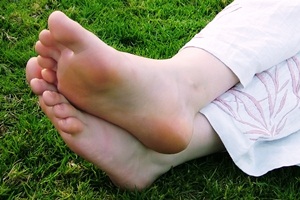What Are “Flat Feet”?
 Flat feet (sometimes referred to as “fallen arches”) are not difficult to spot. It is a condition where there is either no arch or a very low arch to one or both feet. Whereas the inside of the foot is lifted off the ground in people with normal arches, someone with flat feet will have their entire foot flat on the ground. This can sometimes lead to over-pronation, in which the foot rolls over towards the inside. You can often see the effects of over-pronation if you look at your shoes from the back. The insides of the heels will show greater wear than the outsides.
Flat feet (sometimes referred to as “fallen arches”) are not difficult to spot. It is a condition where there is either no arch or a very low arch to one or both feet. Whereas the inside of the foot is lifted off the ground in people with normal arches, someone with flat feet will have their entire foot flat on the ground. This can sometimes lead to over-pronation, in which the foot rolls over towards the inside. You can often see the effects of over-pronation if you look at your shoes from the back. The insides of the heels will show greater wear than the outsides.
Flat feet are somewhat common, with approximately 20% of the population having them. They can occur at any age, and are sometimes due to a congenital problem. In adults, it is often caused by a lack of physical activity or can be a result of obesity. If the foot is subjected to repetitive micro-trauma, such as when walking or running on hard surfaces on a regular basis, this can cause damage to the posterior tibial tendon (PTT). This tendon is responsible for keeping the arch in position. Other conditions that can weaken this tendon are pregnancy, arthritis and trauma or foot fractures.
Some people experience no pain from having flat feet. However, flat feet can cause misalignment elsewhere, leading to other musculoskeletal problems. These problems may include plantar fasciitis (pain in the heel), Achilles tendonitis, knee pain, shin pain, low back pain, bunions, corns and calluses. The feet may also tire easily.
Many young children have what is called “flexible flat feet,” meaning that their feet are flat when standing, but if they rise up on their toes, the arch appears. These children will usually develop an arch as they grow into adulthood.
If flat feet cause no pain and there is no evidence of other problems being created, there is nothing to worry about. If this is not the case, there are a few treatment options. First, although it may be a good idea to get special orthotics for your shoes for support, it is equally important for your feet to get exercise. If your feet are constantly supported by orthotics, the muscles supporting the arch will atrophy even further. When you are at home, try to go shoeless as often as possible. And if you are lucky enough to live near a beach, walking on sand is one of the best workouts there are to strengthen your feet. Avoid high-impact sports that may put a strain on your feet, and if you are a woman, do not wear high heels.
Your chiropractor can perform adjustments to realign bones that may have become misaligned due to your flat feet. Misaligned bones can contribute to the problem and may cause secondary pain in areas such as the knees, hips and lower back. In addition, your chiropractor can provide you with exercises to stretch and strengthen the relevant muscles, in addition to suggesting appropriate orthotics, if necessary.